A Sales Agreement is a vital legal document that outlines the terms and conditions of a transaction between a buyer and a seller. It defines the rights, obligations, and…
continue reading
50+ Sample Indemnity Agreement Templates
-

Sample Indemnity Agreement Template
download now -

General Indemnity Agreement
download now -

Release and Indemnity Agreement
download now -

Avoiding Indemnity Agreement Surprises
download now -

Email Indemnity Agreement
download now -

Simple Indemnity Agreement Template
download now -

Release Indemnity Agreement
download now -

Student Indemnity Agreement
download now -
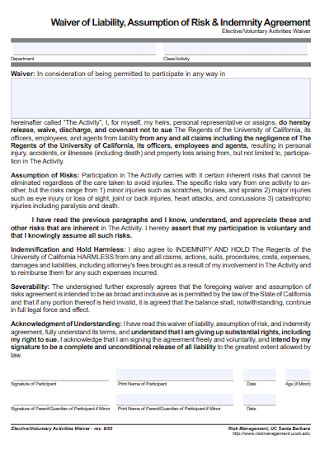
Assumption of Risk Indemnity Agreement
download now -

Construction Indemnity Agreement
download now -

Bond and Indemnity Agreement
download now -

Basic Indemnity Agreement Template
download now -

Insurance and Indemnity Agreement
download now -

Mutual Indemnity Agreement
download now -
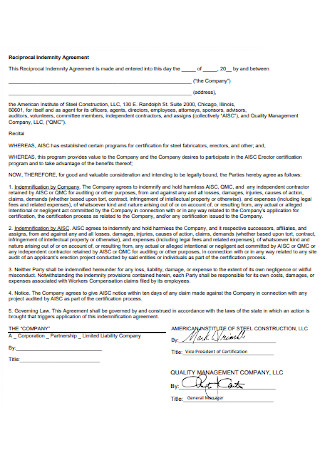
Reciprocal Indemnity Agreement
download now -

Capital Indemnity Agreement
download now -
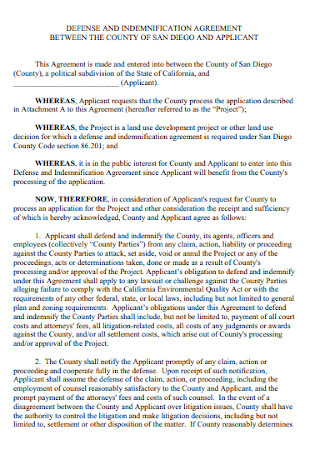
Defense Indemnity Agreement
download now -
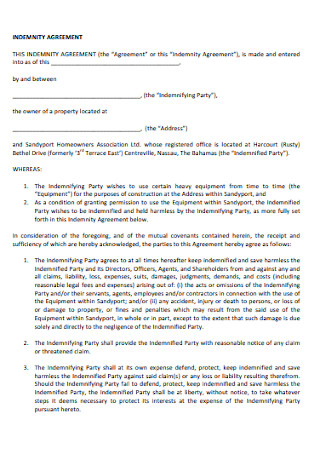
Indemnity Agreement Format
download now -

Sample General Indemnity Agreement
download now -

Seller Indemnity Agreement
download now -

Formal Indemnity Agreement Template
download now -

Facility Usage Indemnity Agreement
download now -

Indemnity Agreement for Open Estate
download now -

Release and Indemnity Agreement Example
download now -

Personal Injury Indemnity Agreement
download now -

Standard Indemnity Agreement Template
download now -

Subcontractor Insurance and Indemnity Agreement
download now -

Liability Indemnity Agreement
download now -

Licence and Indemnity Agreement
download now -
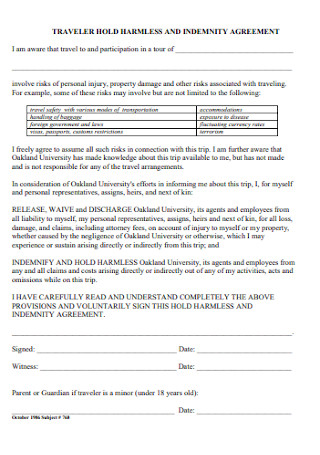
Traveler Indemnity Agreement
download now -

Owner Affidavit and Indemnity Agreement
download now -

Maintenance and Indemnity Agreement
download now -

Printable Indemnity Agreement Template
download now -

Certificate of Contractor and Indemnity Agreement
download now -

Simple Maintenance Indemnity Agreement
download now -

Confidentiality Indemnity Agreement
download now -

Access and Indemnity Agreement.
download now -

Third Party Guarantee Indemnity Agreement
download now -

Indemnity Agreement Checklist
download now -

Volunteer Release of Indemnity Agreement
download now -

Risk Indemnity Agreement Template
download now -
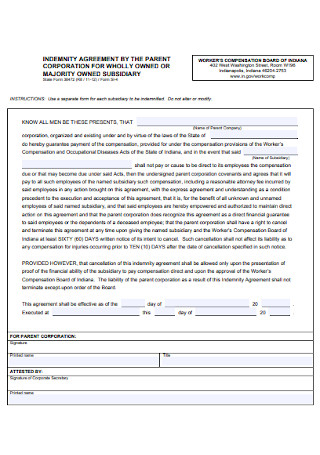
Indemnity Agreement of Corporation
download now -

Funds Declaration and Indemnity Agreement
download now -

Sewer Indemnity Agreement
download now -

Transfer Indemnity Agreement
download now -

Visitor Indemnity Agreement
download now -

Foreclosure Indemnity Agreement
download now -

Nail Indemnity Agreement
download now -

Internship Release and Indemnity Agreement
download now -

Environmental Undertaking And Indemnity Agreement
download now -

Simple Facility Usage Indemnity Agreement
download now
What Is an Indemnity Agreement?
You often hear the word ‘indemnity’ in talking about insurance or compensation. But what exactly is it? To prevent confusion, Investopedia introduces us to two meanings of indemnity. First, indemnity refers to security—which compensates any damage or loss. On another note, indemnity exempts any business or party from any liability for damage. And the indemnification, aka hold harmless, must be spelled out in a written form of agreement or contract. Thus, an indemnity agreement binds two parties to settle terms on how risks, losses, and damages are compensated.
Did you know that the insurance industry in the US had a net premium total of $1.22 trillion in 2018?
According to Statista, more than half of the UK warranty and indemnity insurance (W&I) was caused by a tax breach in 2009–2019.
Also, Reuters mentioned that Congress mandated $1 billion to confront the bird flu epidemic, which affected the US poultry business between 2014 and 2015. And, the US Department of Agriculture (USDA) gave $600 million to fight the virus and $200 million indemnity payments.
Why Is an Indemnity Agreement Important?
Indemnity agreements and clauses are standard in business for a series of reasons. First, the written agreement outlines every term in which parties must comply. And since parties sign the form, the agreement takes effect as regulated. For example, a car insurance company is already obligated to pay for a client’s vehicle engine damage if covering the cost has been written under the document. And every party can look back in the form to be reminded about the regulations and corresponding duties.
Also, the indemnity agreement helps in settling legal action. What if one party commits a breach of contract? If the person who committed the offense refused to do the consequences promised in the agreement, then the obedient party can file for litigation. And that obedient party would win the case if the consequences for breaching were stipulated clearly in the form. The point is indemnity agreements prevent issues regarding liability exemptions or insurance compensations.
Who Creates the Indemnity Agreement?
Indemnification commonly involves an agreement between a person and a business. Also, it can work between companies, government entities, and more if relationships are between a bigger scale. But one thing is sure—indemnity agreement consists of the indemnitee and the indemnifier. The indemnitee refers to the individual or business protected from particular liabilities. Meanwhile, an indemnifier is the designated party to reimburse an indemnitee for specific claims. If you base the example between the skydiving example discussed earlier, the skydiving business is the indemnitee, and the skydiver or customer is the indemnifier.
When to Apply the Indemnity Agreement
You already know indemnity agreements authorize protection from any possible damage, liability, loss, or claim in the involvement of a particular event or activity. But what are other examples of when to use the agreement? Aside from skydiving, a bunch of businesses depends on indemnification for security purposes as well. Here are some examples of when to use indemnity agreements:
How to Make an Indemnity Agreement
In America, the insurance industry dominated in 2018 with a net premium total of $1.22 trillion. That is, according to the Insurance Information Institute. With that massive amount, you can say that lots of people and businesses depend on insurance for security and protection. And just like insurance, indemnity is relevant to prepare for future circumstances of liabilities, damages, and losses. But, that protection might not last without a well-thought-out indemnity agreement. So be sure to know the steps on how to create the indemnity agreement with these steps:
Step 1: Open with an Introductory Statement
First things first, the indemnity agreement label should be clear on top of your agreement form. Using bold capital letters will do. That title or label indicates that the document is about indemnity. And while the title is already clear, start with the introductory statement. From the name itself, introductory statements introduce significant details of the indemnity agreement. It should include when the deal begins to take effect as well as when it ends.
Step 2: Identify All the Parties
Another critical part of the introduction is the party information. Who are the indemnifier and the indemnitee? Note it down. Be clear with the parties’ names and their roles to prevent confusion. And inputting the full and legal names of parties is standard. Remember that writing the wrong names and information can nullify the whole agreement, and you would not want that. Aside from the names, you may need to include everyone’s contact info.
Step 3: Stipulate the Terms
Next, it’s time to face the most challenging part of the agreement?—incorporating the rules, policies, and legal terms. And every detail must be correct from the terms, or the entire message might mean differently. Decide what to agree regarding the indemnified activities, considerations, consent, confidentiality, legal fees, severability, representations, warranties, amendments, waivers, and the governing law.
Step 4: Be Specific
Review everything you have written if they are clear and understandable enough. As it is standard to always correct misspellings and grammatical errors in official forms, your next problem might have something to do with broadness. With this, it means your words and messages might not be specific enough. For example, you might have stated that “the indemnitee seeks protection from indemnified activities.” So what are these indemnified activities? Enumerate them. And are there exemptions from what activities are indemnified? State them as well.
Step 5: Insert the Termination or Dispute Clause
Complete your indemnity agreement with the dispute and termination clause. This section is vital in clarifying what to do in case parties fail to observe the stipulations under the agreement. For example, in the UK, there were more than half of the W&I caused by a tax breach back in 2009–2019. Thus, any breach can be solved instead of blaming who’s liable with the dispute clause. So, what circumstances cut the agreement’s validity aside from the agreement deadline? Include them in the document. And at the bottommost part of the sheet, provide blanks for the indemnitee and the indemnifier’s signature. Those signatures confirm that everybody has read, understood, and agreed on everything.
FAQs
How does indemnity work?
An example of how indemnity works is the true story behind how government entities, businesses, and a whole industry managed a disease outbreak. According to Reuters, the US poultry industry suffered back in 2014 and 2015 because of bird flu. So, Congress mandated around $1 billion to support in stopping the virus. And while USDA gave approximately $600 million to stop bird flu, there was also protection given of about $200 million indemnity payments. Thus, poultry businesses were compensated.
What are the other names of indemnity agreements?
An indemnity agreement can often be associated with many names, but the meanings are just about the same. Examples include the hold harmless agreement, no-fault agreement, release of liability, and waiver of liability.
Should indemnity agreements be created equal?
No. Although you can keep the conditions fair for both sides in an indemnity agreement, there is no rule that this agreement should be created equally. And if the indemnifier feels that the conditions are unfair, simply choose not to sign the form. Nonetheless, always understand the agreement before you sign.
While an indemnity agreement’s function is already clear to you, don’t forget that making that binding agreement is not as basic as to excuse yourself from any liability. Various aspects are considered too. Moreover, you should be careful with every word, detail, and thought inputted in the form because the terms must be reasonable, legal, or ethical. Otherwise, your agreement might not be taken seriously. And with the help of our ready-made sample templates, you are guided on how to structure an excellent indemnity agreement easily.

